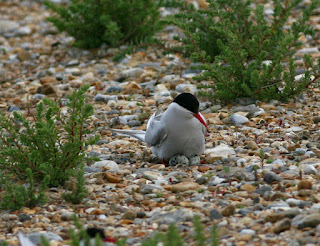My name is Niki Lowndes and I'm you're Blakeney guest blogger for the day. I have been living in the lifeboat house with the Blakeney wardens for the past month whilst carrying out my research project for my Master’s degree in Conservation at UCL. My project looks at the feeding ecology of sandwich terns and is specifically focused on their interactions with the black-headed gulls they nest with. I have been observing the birds at a distance using a scope to ensure my observations do not disturb the nesting birds. This is particularly important because sandwich terns are considered to be of amber conservation status and of European concern due to recent breeding range declines (1969-2007). The Blakeney population is particularly important as it’s the UKs largest Sandwich tern colony, with 3,735 nests being counted this year.
Sandwich tern colony at far point (Niki Lowndes)
I have been observing sandwich terns flying into to colony and recording data on chick provisioning, including prey type, prey size, whether the feeding attempt was successful and if not why not. In brief my observations showed that the terns were feeding chicks primarily sand eels and clupeids with the odd squid, crustacean and invertebrate being brought back.
Sandwich tern feeding chick a sand eel (Niki Lowndes)
Sandwich terns nest with black-headed gulls because they provide protection from other predators, including common gulls, herring gulls and birds of prey, which would take tern chicks. However, with these benefits come consequences and the black-headed gulls will steal fish from the terns, this is known as kleptoparasitism. I also observed black-headed gulls eating tern chicks whole when they were young and small enough, this was pretty horrible to watch on account of the chicks being so cute!
Sandwich tern chick spreading its wings (Niki Lowndes)
The gulls were persistent and would follow a tern with a fish in aerial pursuit preventing the tern landing as many as 15 times. Sometimes they would mob the terns in large numbers, I observed as many as ten gulls mobbing one tern and pushing it to the ground to obtain a fish. As well as aerial theft from the adult tern, I observed the gulls stealing food directly from the chick’s mouth; sometimes the chick would hold onto the fish and be dragged into the air and dropped from height. The likelihood of kleptoparasitism increased with the size of the fish and bringing back clupeids was the most risky because they are highly reflective and therefore draw more attention from the gulls.
Black-headed gulls fighting over a stolen sand eel, with a hungry tern chick waiting for a dinner which won't come (Niki Lowndes)
It isn't all bad news and the terns will sometimes out fly the gulls. They do also fight back and will protect feeding chicks using their wings to shield the chicks from the gulls. I also observed a rather altruistic oystercatcher who was nesting nearby attack a black-headed gull which was attacking a tern chick.
Sandwich tern protecting chick from black-headed gull (Niki Lowndes)
This year as well as having to deal with black-headed gull piracy, the sandwich terns have had to deal with particularly poor summer weather, with high winds and cold rains being frequent. Despite all these trials and tribulations the good news is that yesterday we observed the first fledged sandwich tern chicks.
In other news, the little tern colony is having less success and due to the aforementioned poor weather and a heron getting into the colony on Tuesday, only a few chicks have hatched so far. Many birds are, however, still incubating eggs so hopefully these will hatch soon and we'll keep you updated with their progress.





































